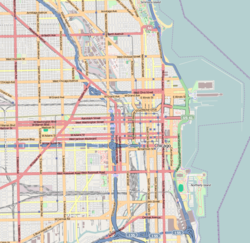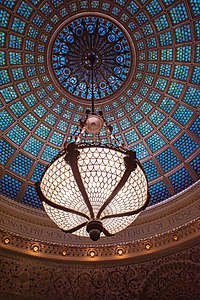|
Chicago Cultural Center
Preston Bradley Grand Hall and Tiffany domes Preston Bradley Hall Preston Bradley Hall and Tiffany glass dome The Chicago Cultural Center, opened in 1897, is a Chicago Landmark building operated by Chicago's Department of Cultural Affairs and Special Events. The Cultural Center houses the city's official reception venue, where the Mayor of Chicago has welcomed presidents, royalty, diplomats, and community leaders. It is located in the Loop, across Michigan Avenue from Millennium Park. Originally the main library of the Chicago Public Library, the building was converted in 1978 to an arts and culture center at the instigation of Commissioner of Cultural Affairs Lois Weisberg. The city's central library is now located across the Loop in the spacious, postmodern-style Harold Washington Library Center, which opened in 1991. As the nation's first free municipal cultural center, the Chicago Cultural Center is one of the city's most popular attractions and is considered one of the most comprehensive arts showcases in the United States. Each year, the Chicago Cultural Center features more than 1,000 programs and exhibitions covering a wide range of the performing, visual and literary arts. It also serves as headquarters for the Chicago Children's Choir. ArchitectureThe building was designed by Boston architectural firm Shepley, Rutan and Coolidge for the city's central library, and Grand Army of the Republic (GAR) meeting hall and memorial in 1892. The land was donated by the GAR and the building was completed in 1897 at a cost of nearly $2 million (equivalent to $73.25 million in 2023). It is organized as a four-story north wing (77 East Randolph entrance) and a five-story south wing (78 East Washington entrance), 104 ft (32 m) tall, with 3-foot-thick (0.91 m) masonry walls faced with Bedford Blue Limestone on a granite base. The building is designed in a generally neoclassical style, with Italian Renaissance elements. It is capped with two stained-glass domes, set symmetrically atop the two wings. Key points of architectural interest are as follows:
RenovationThe Chicago Cultural Center underwent an extensive[4] renovation during 2021–2022[5] with the goal of unearthing the original beauty of the building. The detailed restoration of the art glass dome and decorative finishes in the Grand Army of the Republic rooms, a Civil War memorial, was made possible by a grant of services valued at over $15 million to the City of Chicago. The Chicago Cultural Center is home to two noteworthy stained glass domes.[6] Chicago-based Harboe Architects was awarded the project. The scope of the project[7] included recreating long-lost light fixtures, cleaning and polishing old marble, restoring mahogany doors, installing new glass, and removing layers of paint in the historic rooms. Also included in the scope was the complete restoration of the 40 ft (12 m) diameter[8] Tiffany-designed stained glass dome, which had become covered in grime and paint. The dome contains over 60,000 individual pieces of glass. Daprato Rigali Studios of Chicago performed the stained-glass dome restoration.[9] Past exhibitionsCrossroads: Modernism in Ukraine, 1910–1930 was a display of art by Ukrainian artists, such as Sukher Ber Rybak, Vsevolod Maskymovych, and Oleksandr Bohomazov, to name a few. Crossroads was organized by the Foundation for International Arts and Education with the National Art Museum of Ukraine. It was presented by the Chicago Department of Cultural Affairs and the Kyiv Committee of the Chicago Sister Cities International Program. The exhibition ran from July 22, 2006 until October 15, 2006. Richard Hunt: Sixty Years of Sculpture was a major exhibition of sixty sculptures spanning Hunt's career. The exhibition drew primarily from his extensive "self-collection", lent to the center for the show. This exhibition ran from December 6, 2014, through March 29, 2015.[10] "Rush More" muralIn 2017, Kerry James Marshall was commissioned to produce an inaugural mural for a public arts program. The mural entitled "Rush More" is located on the west façade of the cultural center. The piece is an homage to women who have contributed to the culture of Chicago.[11] Portrayed are:
Washington painted the mural on a scale rendering of the building. The piece was then transposed to the actual façade by the muralist Jeff Zimmerman.[13] Financing for the project was made possible by the non-profit, Murals of Acceptance and through philanthropic donations from David Arquette, Patricia Arquette, Marc Benioff, and Lynne Benioff.[14] See alsoReferences
External linksWikimedia Commons has media related to Chicago Cultural Center.
|
||||||||||||||||||||||||||||






